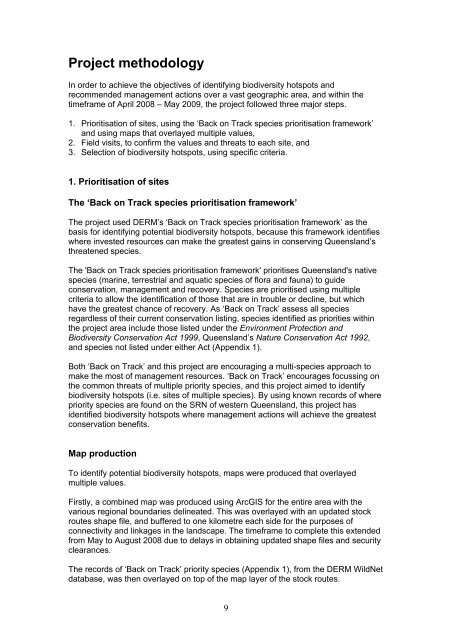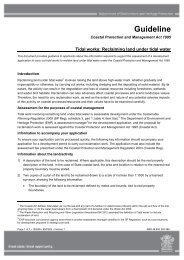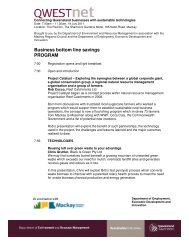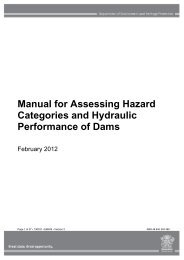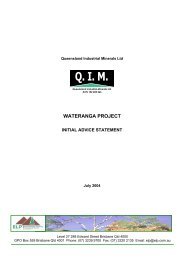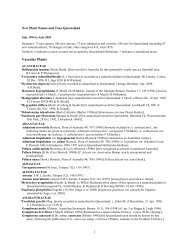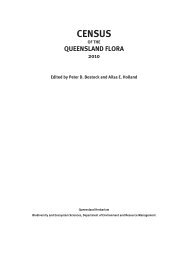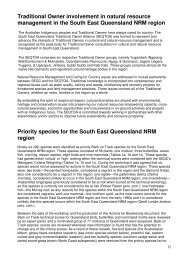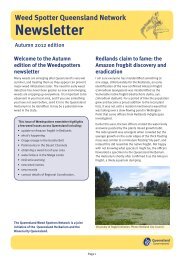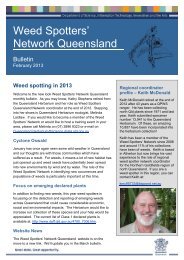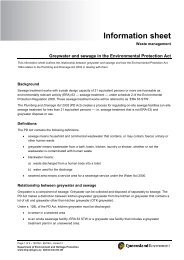Enhancing Biodiversity Hotspots Along Western Queensland Stock ...
Enhancing Biodiversity Hotspots Along Western Queensland Stock ...
Enhancing Biodiversity Hotspots Along Western Queensland Stock ...
Create successful ePaper yourself
Turn your PDF publications into a flip-book with our unique Google optimized e-Paper software.
Project methodology<br />
In order to achieve the objectives of identifying biodiversity hotspots and<br />
recommended management actions over a vast geographic area, and within the<br />
timeframe of April 2008 – May 2009, the project followed three major steps.<br />
1. Prioritisation of sites, using the ‘Back on Track species prioritisation framework’<br />
and using maps that overlayed multiple values,<br />
2. Field visits, to confirm the values and threats to each site, and<br />
3. Selection of biodiversity hotspots, using specific criteria.<br />
1. Prioritisation of sites<br />
The ‘Back on Track species prioritisation framework’<br />
The project used DERM’s ‘Back on Track species prioritisation framework’ as the<br />
basis for identifying potential biodiversity hotspots, because this framework identifies<br />
where invested resources can make the greatest gains in conserving <strong>Queensland</strong>’s<br />
threatened species.<br />
The 'Back on Track species prioritisation framework' prioritises <strong>Queensland</strong>'s native<br />
species (marine, terrestrial and aquatic species of flora and fauna) to guide<br />
conservation, management and recovery. Species are prioritised using multiple<br />
criteria to allow the identification of those that are in trouble or decline, but which<br />
have the greatest chance of recovery. As ‘Back on Track’ assess all species<br />
regardless of their current conservation listing, species identified as priorities within<br />
the project area include those listed under the Environment Protection and<br />
<strong>Biodiversity</strong> Conservation Act 1999, <strong>Queensland</strong>’s Nature Conservation Act 1992,<br />
and species not listed under either Act (Appendix 1).<br />
Both ‘Back on Track’ and this project are encouraging a multi-species approach to<br />
make the most of management resources. ‘Back on Track’ encourages focussing on<br />
the common threats of multiple priority species, and this project aimed to identify<br />
biodiversity hotspots (i.e. sites of multiple species). By using known records of where<br />
priority species are found on the SRN of western <strong>Queensland</strong>, this project has<br />
identified biodiversity hotspots where management actions will achieve the greatest<br />
conservation benefits.<br />
Map production<br />
To identify potential biodiversity hotspots, maps were produced that overlayed<br />
multiple values.<br />
Firstly, a combined map was produced using ArcGIS for the entire area with the<br />
various regional boundaries delineated. This was overlayed with an updated stock<br />
routes shape file, and buffered to one kilometre each side for the purposes of<br />
connectivity and linkages in the landscape. The timeframe to complete this extended<br />
from May to August 2008 due to delays in obtaining updated shape files and security<br />
clearances.<br />
The records of ‘Back on Track’ priority species (Appendix 1), from the DERM WildNet<br />
database, was then overlayed on top of the map layer of the stock routes.<br />
9


